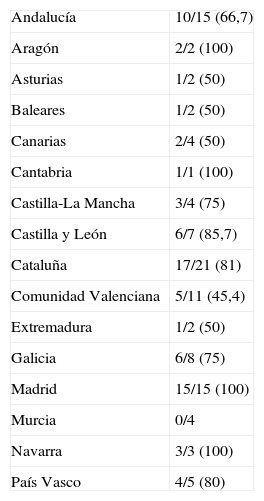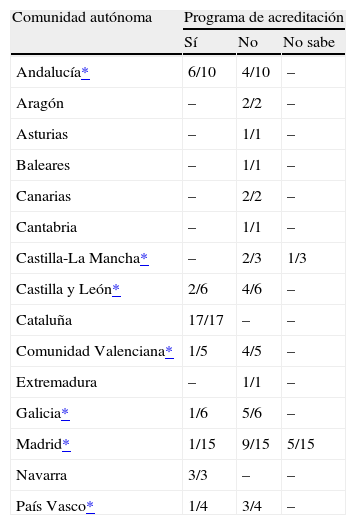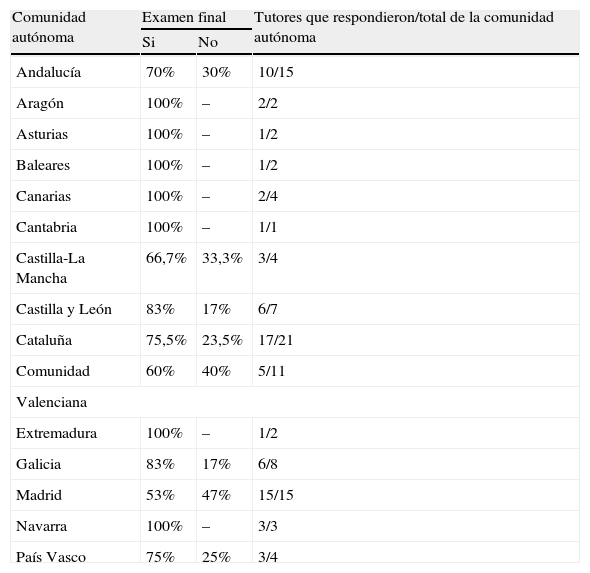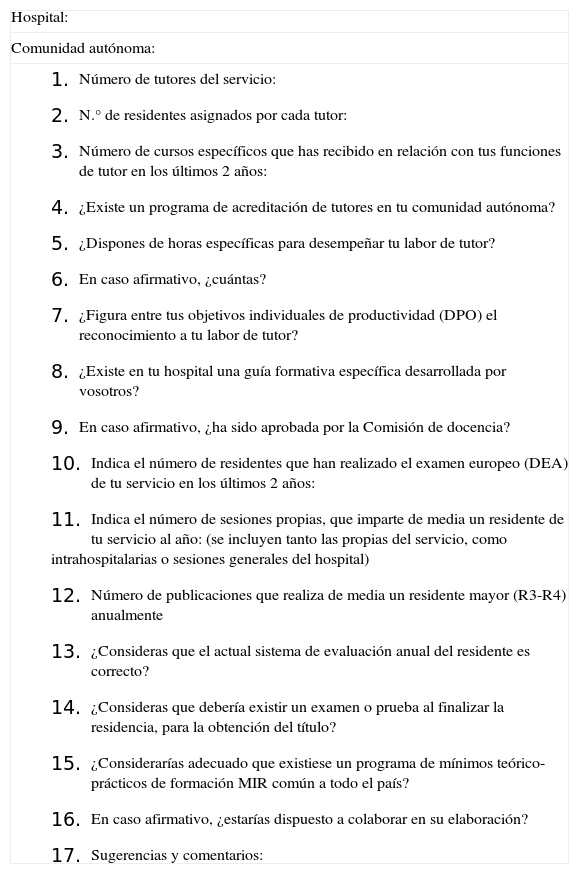Conocer la situación actual de los tutores de nuestra especialidad en cuanto a proporciones residentes/tutor, tiempos de que disponen para desarrollar su labor, la formación que han recibido para realizar su función y si esta es reconocida por los organismos oficiales, más allá de su propio hospital. Asimismo conocer la labor docente e investigadora de los residentes a través de las sesiones que realizaban y las publicaciones anuales en que eran partícipes. Conocer la opinión de los tutores respecto a la unificación de contenidos formativos, que se realicen o no pruebas objetivas al concluir la residencia y su disposición a colaborar en el proyecto, promovido desde la Sección de Docencia de la SEDAR, de colaborar en la aplicación de un programa de mínimos teóricoprácticos común a todo el territorio nacional.
Material y métodosSe envió a los tutores de las unidades docentes de Anestesiología, a través de diferentes coordinadores territoriales, una encuesta con las cuestiones anteriores, durante los años 2008–2010.
ResultadosContestaron 77/106 unidades docentes (72,6%). La razón media de residentes por tutor era 5,6 ± 3,3. Más de un 60% de los tutores no habían recibido ningún curso de formación o a lo sumo uno en 2 años, el 62,3% no disponía de tiempos específicos para desarrollar su función de tutores y su labor sólo era reconocida por las instituciones sanitarias en un 18,2%. El número de sesiones impartidas por los residentes al año era 5,0 ± 4,0 y el número de publicaciones, 1,6 ± 1,4. El 98,7% creía necesaria la elaboración de un programa que garantice unos mismos planes formativos teórico-prácticos mínimos y que, a título individual, habían realizado en un 70% de las unidades docentes, pero sin criterios uniformes. El 74% de los hospitales no habían presentado a ningún residente al Examen Europeo de Anestesia en los últimos 2 años, no se consideraba adecuado el sistema de evaluación de los residentes en un 87%, y un 79% era partidario de realizar un examen o prueba final.
ConclusionesDebe adecuarse la razón residentes/tutor según lo estipulado. Es necesario disponer de un tiempo para la docencia, separado del asistencial y nuestros tutores carecen, en general, de cursos específicos de formación, y estos son muy dispares. Existe una demanda generalizada de realizar un programa formativo común de competencias y mínimos teórico-prácticos. Se considera que el actual sistema de evaluación no es el adecuado, pero no hay unanimidad en si realizar o no un examen al final de la residencia, aunque el modelo del examen europeo podría ser una prueba que considerar a este respecto.
To determine the current situation of the tutors in our specialty as regards resident/tutor ratios, times they have available to develop their work, the training that they have received to perform their function, and whether this is recognised by official bodies, other than by their own hospital. Furthermore, to determine the teaching and research work taught to the residents through the sessions, as well as their participation in publications per year. To find out their opinion of the tutors as regards unifying training contents, whether or not they have objective tests on finishing their residency, and their willingness to take part in the project promoted by the Teaching Section of SEDAR to carry out a common minimum theoretical-practical programme throughout the whole of Spain. Material and methods: A questionnaire with the aforementioned questions was sent to Anaesthesiology Teach Units through the different regional coordinators, during the years 2008–2010.
ResultsA total of 77/106 (72.6%) Teaching Units responded. The mean ratio of residents per tutor was 5.6±3.3. More than 60% of the tutors had not attended any training course or even how to join one in the two years of the study; 62.3% did not have specific time available to develop their role as tutors, and in 18.2%, their work was only recognised by health institutions. The number of teaching sessions for residents per year was 5.0±4.0 and the number of publications was 1.6±1.4. Almost all of them (98.7%) believe it was necessary to produce a programme that would ensure similar minimum theoretical-practical training plans and that on their own initiative had been carried out in 70% of Teaching Units, but without uniform criteria. Almost three-quarters (74%) had not presented any resident to the European Examination of Anaesthesia in the last few years, and 87% considered the system of evaluating residents as inadequate, with 79% in favour of having a final exam or test.
ConclusionsThe tutor/resident ratio should according to that stipulated. Time needs to be set aside for teaching, separate from care work, and our tutors, in general, lack specific training courses, and these are very disparate. There is a general demand to have a training programme of common minimum theoretical-practical skills. It is considered that the current evaluation system is inadequate, but there is no unanimity in whether or not to have an exam at the end of the residency, although the European Examination could be the model to consider in this regard.
Artículo
Comprando el artículo el PDF del mismo podrá ser descargado
Precio 19,34 €
Comprar ahora













